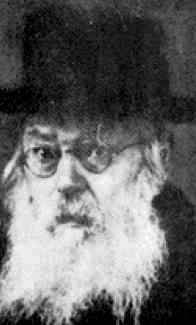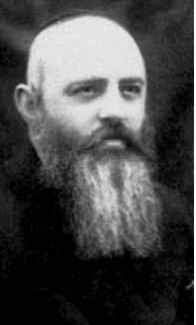 |
 |
Chief Rabbi Avraham-Shlomo Hirsch
|
Translated by Dorothy Gross Nadosy
A substantial part of the album refers to a time which still remains in our memory: the years between the two world wars, recalling the days of the Masaryk democracy in Czechoslovakia and the pre-Holocaust years.
Excellent images of public figures cannot be obtained of those who played a central role in community life: presidents of the Jewish community, social, economic, religious and other major public institutions. The reason: we do not have access to the archives to foreign and especially the Beregszász community archives (if they exist). Therefore for not only the pictures in this chapter, but also for the rest of the pictures, all in those images experienced catastrophe in the strictest sense of the word. Most still exist in the free world; others add to the last memories of our families and our city.
Respectfully, we open this album depicting the now nonexistent Jewish community by beginning the first chapter with selected pictures of the city's main synagogue and rabbis.
In the Diaspora Jewish community life, the most important, prominent and the central institution was the synagogue. The Jewish community's first prominent and respectable personalities: the rabbis. We were proud of all of them!
Foremost is the grand Beregszász synagogue's impressive ornamental building, built in the heart of the city in the past century. Clearly, this was a thorn in the side of anti-Semites, but the Jewish synagogue stood untouched even when those praying left for the heavens. And the Russian “liberators” (who were in no hurry to destroy rail lines leading to Auschwitz and bomb the gas chambers) made sure that this historically significant place, with excellent engineering components - was eliminated from the Beregovo map! That a theater or dance hall was erected in their place did not change their essence. If we do not not have left physically a quarter of the synagogues - of which even the irreligious were proud - we have preserved the image of symbolic reliefs on the temple and of tombs in the cemetery. The synagogue itself, as the community around it, is unforgettable and will remain an indelible part of the future generations.
There were still more Beregszasz synagogues, but no pictures of them remain. Some of them were extremely religious, leading their lives as a closed group. There are no statistics and no details about them, but as their fate was the same as the rest of our fellow believers, their memories have been merged into the memory of our faith.
We have seen books that capture communities similar to ours. For the most part, they deal with detailing their cities' rabbinic dynasties. Although the elected “presidents of the Jewish community” and caretakers stood as the head of Jewish public life, the religious and moral authority was the rabbi. In this period covered by this album, Beregszasz Jews were headed by a total of two prominent rabbis. Shlomo Sofer Schreiber (Chatam Sofer's grandson born in 1844), looked patriarchal, dignified, and respectable. After his death (1930), Avraham Shlomo Hirsch wore the head rabbi's robe; he was “more modern,” conjuring up the memory of Herzl.
There were, of course, religious institutions where hundreds of children studied: Talmud Torah, Yesodot HaTorah, and in various yeshiva rabbis' “courts”. The largest among them was the Bnei Asher yeshiva, peaking under Hungarian rule, whose hundreds of students brought honor to the Beregszász Jews
In a democratic institution, such as the Jewish communities' cooperative, the chairmen and management alternated. Unfortunately, we can mention just a few names among the outstanding personalities who served the city's Jewish population in the years between the two world wars; we did not know all the names, much less obtain the images; Sandor Vári, Lajos Herskovits, Fisl Hartmann, Dr. Bela Szekely, Jakab Mermelstein (Kozarek), Albert Fodor, Hermann-Zvi Schonfeld, and Salamon Schwartz (who was the president of the Chevra Kadisha). Here we mention the great synagogue cantor Liebermann, who also worked with the choir under his son Jerucham's leadership.
In the community building's courtyard, a wide and changing variety of activities took place: Hebrew elementary, communal kitchen, kosher butcher shops, poultry cutting, Passover baking, etc. We understand that (so far) the Jewish cemetery is intact, but unfortunately, there is no reason to doubt that the album's two small pictures will be the last memories of the place where they love, they cry, those who have given the last respect for the Jewish religion.
When we talk about outstanding personalities, it is no boast that the Beregszász Jews provided extraordinary representatives to the science, literature, art or sports world. But we can be proud that the average human material level was definitely higher than normal. In society usually those citizens who bear the public burden are those who simply understand and work with the problems in their environment. We have selected a few old friends who represent different walks of life (medicine, art, literature, military) and have published their pictures. Presumably, after the album's release, good friends will discover the city of “long ago” that - unfortunately - we cannot find at this time.
We know for example that there was Hugó Vincze, the first government commissioner attached to the the city of Beregovo in Czechoslovakia.; that Dr. Sándor Krohn was the Transcarpathian Regional Assembly representative; that Ignác Rottman filled the city office of deputy mayor. But we have not received further information or images about them or others. But we do not intend to just “decorate” ourselves with big names, but also to reflect on the miraculous image of Judaism, which was so rich in life and morals, and those individuals in public life and in their minds who voluntarily and honestly worked for his fellow man, each one into his own work in his field.
To conclude this chapter, we will quote from our city's writer, Sándor Jakubovics-Jak's short story (“Prophet Elijah and Uncle Nathan”):
”... This small chapel adorned the Mermelstein courtyard. This word I write only out of respect for the synagogue, because the chapel was certainly a battered building but belonged to the heart. Even today, after such a long time, it comes to life in front of him, as if he had stepped into the shabby brown door. . . .I can hear the old Weiszhausz grunting, I see Grünfeld with easily-teased restless eyes, pay attention to Uncle Goldberger seated in the second row praying, the mobile Slomovits, who was walking up and down praying. Nearly again in the left corner, I feel the fireplace stove's heat after the evening prayer, not just foolish conversation.”
These “institutions” and “personalities” are rightly proud to make Beregszász unforgettable, dear Jews.
Thus were our town's Jewish citizens.
|
|
|||
Chief Rabbi Avraham-Shlomo Hirsch |
|
|
|
|
|||
President of the Jewish Community |
President of the Jewish Community |
|
|
|||
President of the “Talmud Torah” Community |
|
|
|||
President of the Jewish Community |
a founder of “Mizrachi” |
|
|
|||
the “shamash” of the Great Synagogue |
|
|
(accompanied by Dr. Ede Kertész) |
|
|
|
|
|
|
|||
(“Yiddishe mame”) |
|
|
|||
|
|
surgeon, leader, friend |
|
|
the most decorated officer of the Czechoslovakian Army |
|
|
internationally known painter |
|
|
military attaché to three Presidents of Israel |
|
|
|
|
and friend (1977) |
|
|
|
JewishGen, Inc. makes no representations regarding the accuracy of
the translation. The reader may wish to refer to the original material
for verification.
JewishGen is not responsible for inaccuracies or omissions in the original work and cannot rewrite or edit the text to correct inaccuracies and/or omissions.
Our mission is to produce a translation of the original work and we cannot verify the accuracy of statements or alter facts cited.
 Berehove, Ukraine
Berehove, Ukraine
 Yizkor Book Project
Yizkor Book Project
 JewishGen Home Page
JewishGen Home Page
Copyright © 1999-2026 by JewishGen, Inc.
Updated 1 May 2021 by LA